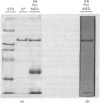Abstract
Hormonally produced changes in the synthesis and secretion of the serum copper-containing protein caeruloplasmin were studied in primary cultures of rat liver parenchymal cells isolated by the collagenase-perfusion technique. A rabbit antibody directed against rat caeruloplasmin was used to immunoprecipitate labelled caeruloplasmin. Isolated liver cells synthesized and secreted caeruloplasmin over a period of 3 days. Synthesis and secretion of this protein was enhanced when cells were treated with dexamethasone. The accumulation of copper was also moderately enhanced with glucocorticoid treatment. Inclusion of adrenaline in the culture medium resulted in elevated incorporation of copper into newly synthesized caeruloplasmin as well as an increase in 64Cu-labelled caeruloplasmin in the culture medium. However, adrenaline did not seem to increase the secretion of 3H-labelled protein, despite the elevation in secreted 64Cu-caeruloplasmin. This may be due to a large increase in the intracellular pool of 64Cu caused by enhanced accumulation of this metal when adrenaline is included in the incubation medium. Enhanced copper accumulation was also seen when cells were treated with glucagon. Adrenaline-stimulated accumulation of 64Cu could be inhibited by including phenoxybenzamine, an alpha-adrenergic blocker, in the culture medium. Elevation of extracellular copper caused enhancement in the detection of labelled caeruloplasmin in the medium of cultured cells, probably owing to the ability of this metal to stabilize the protein.
Full text
PDF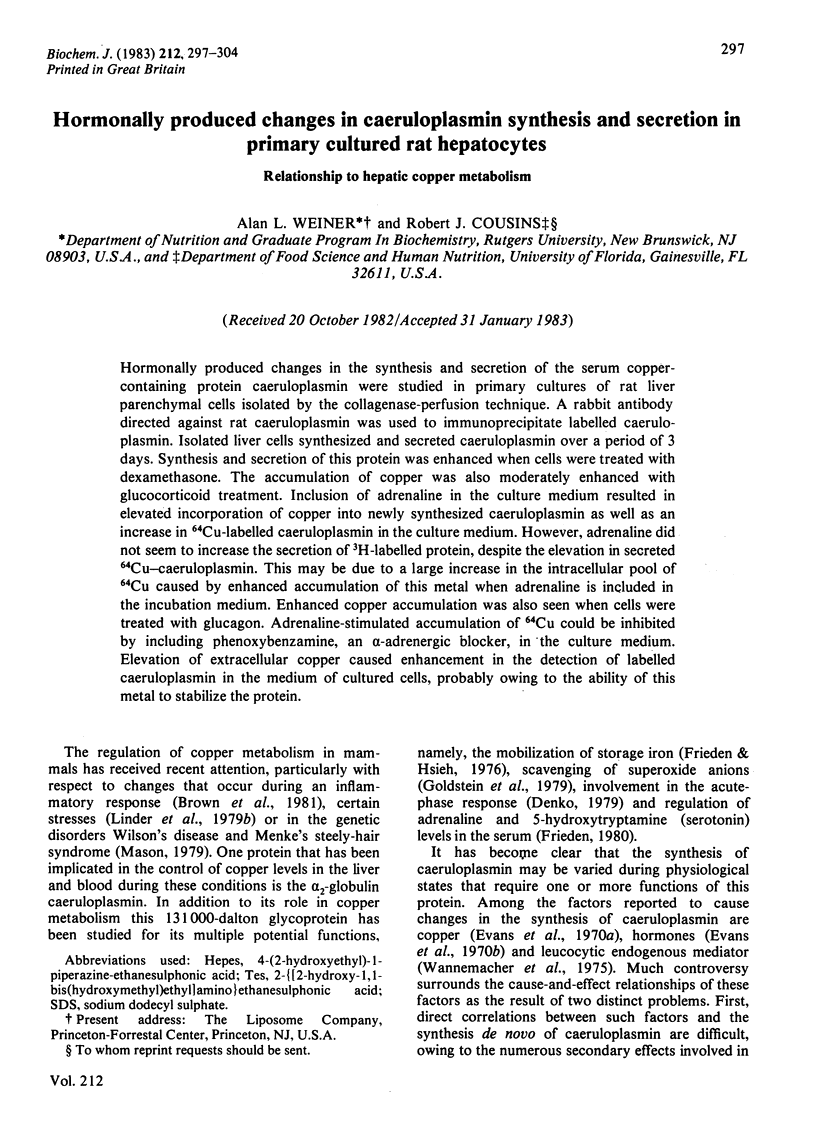
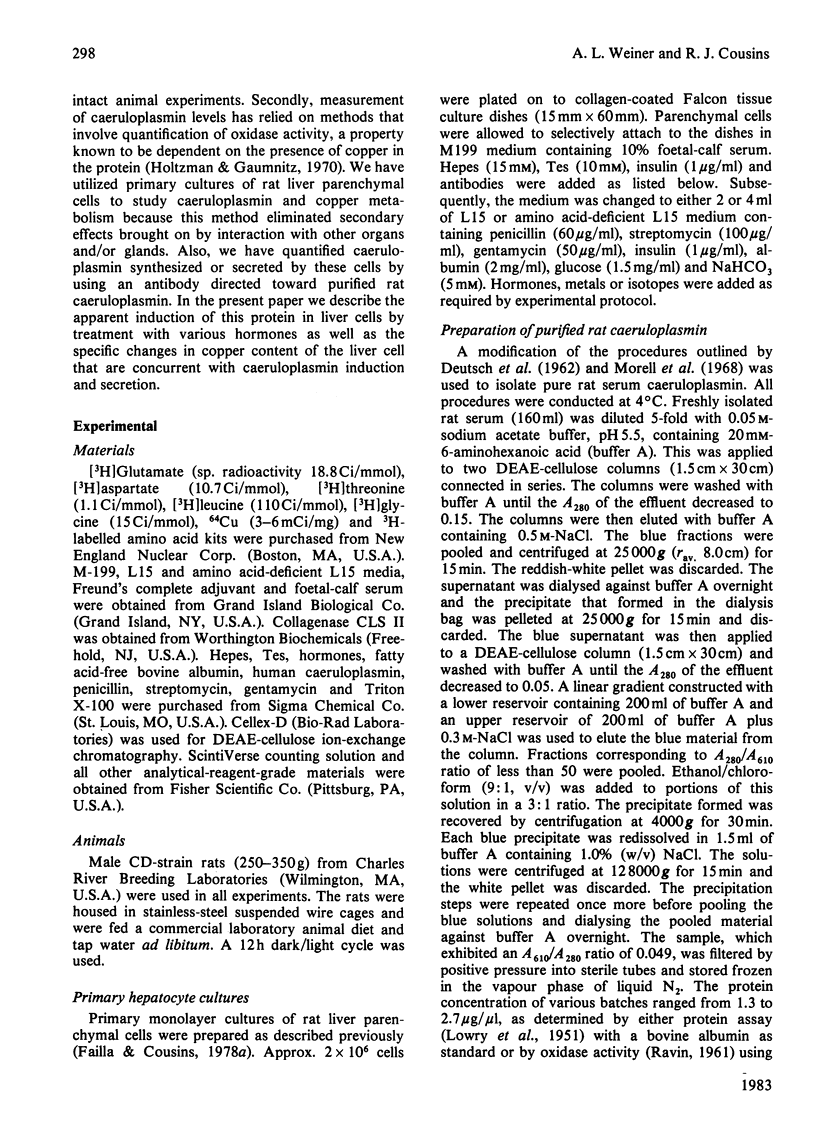
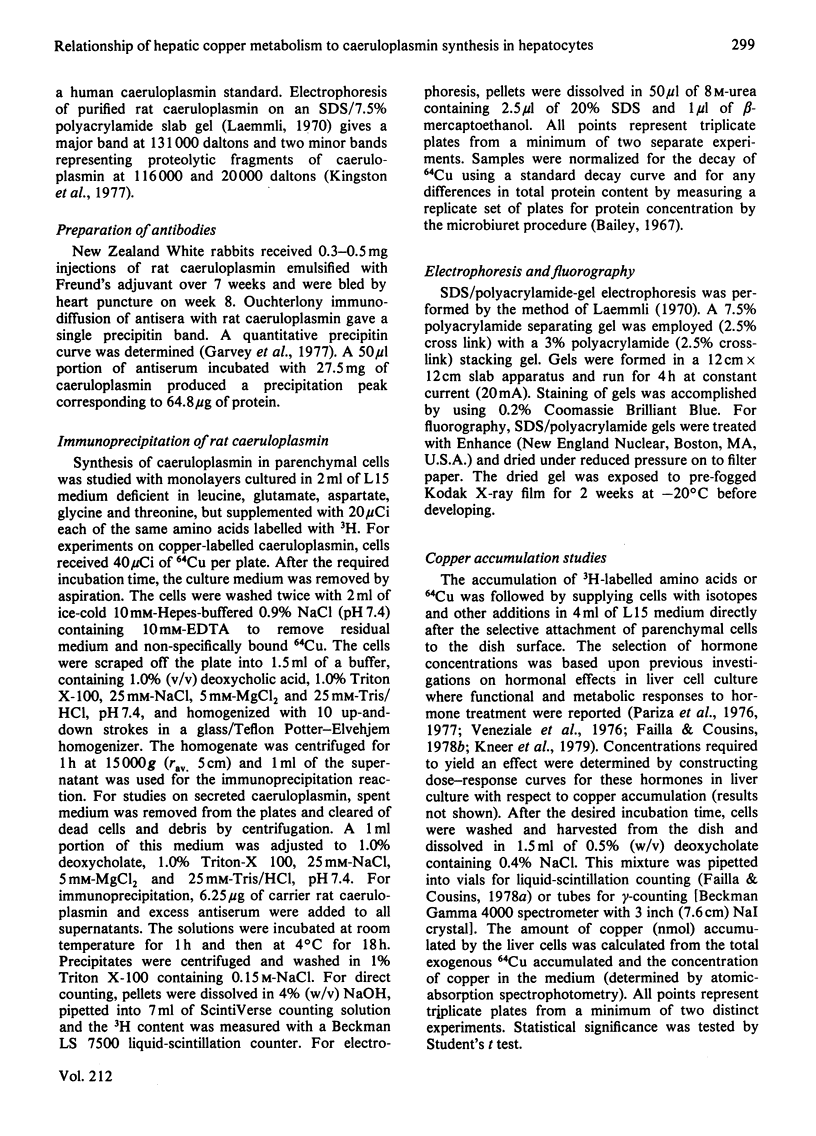
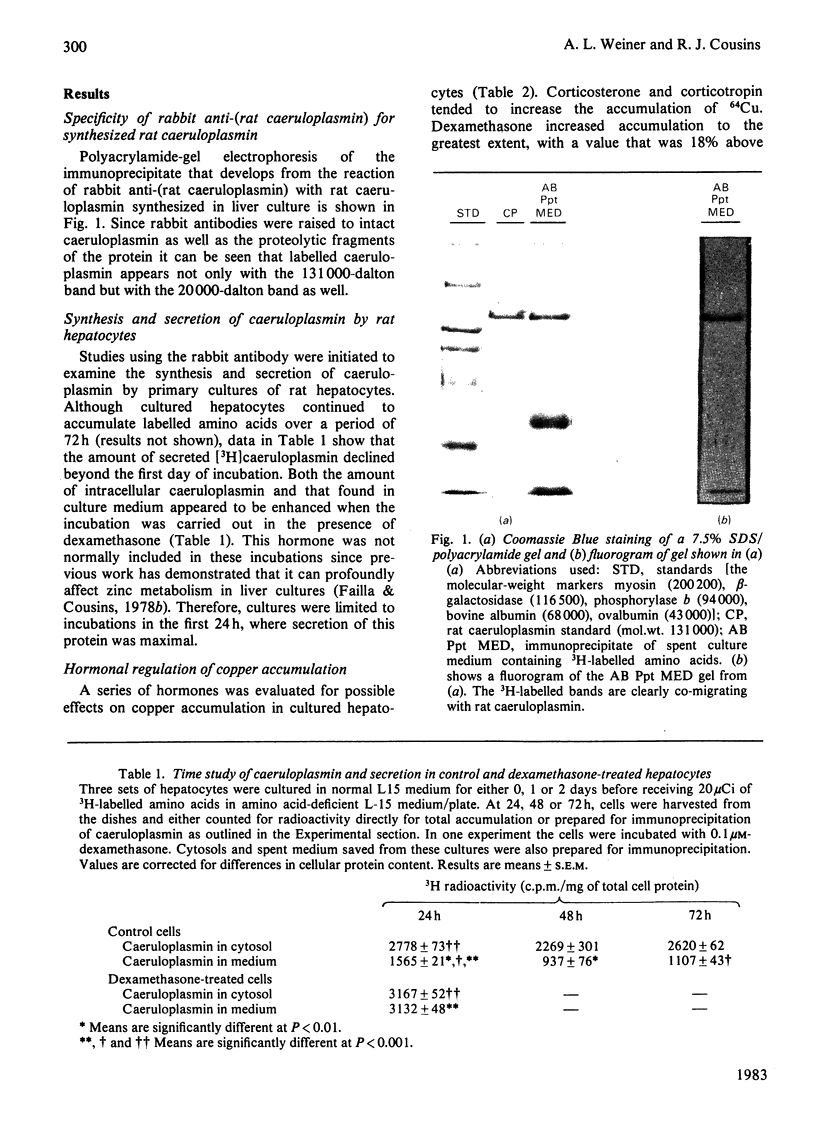
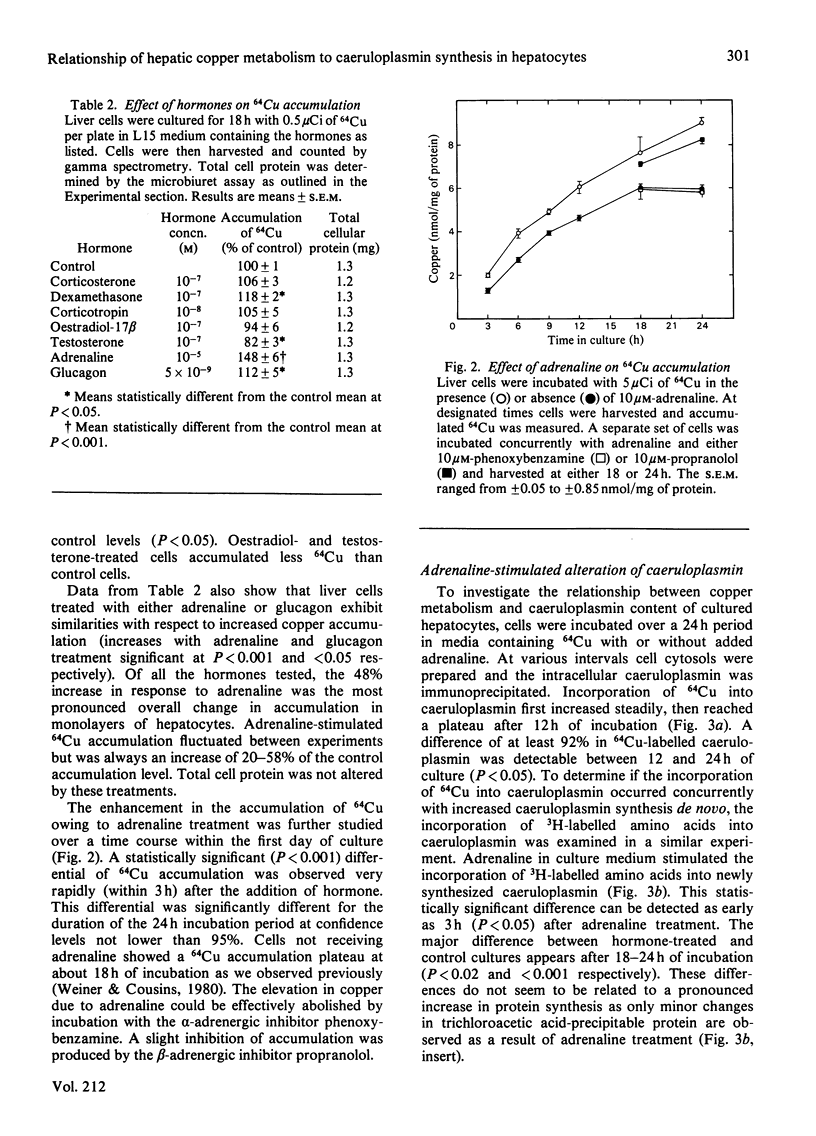
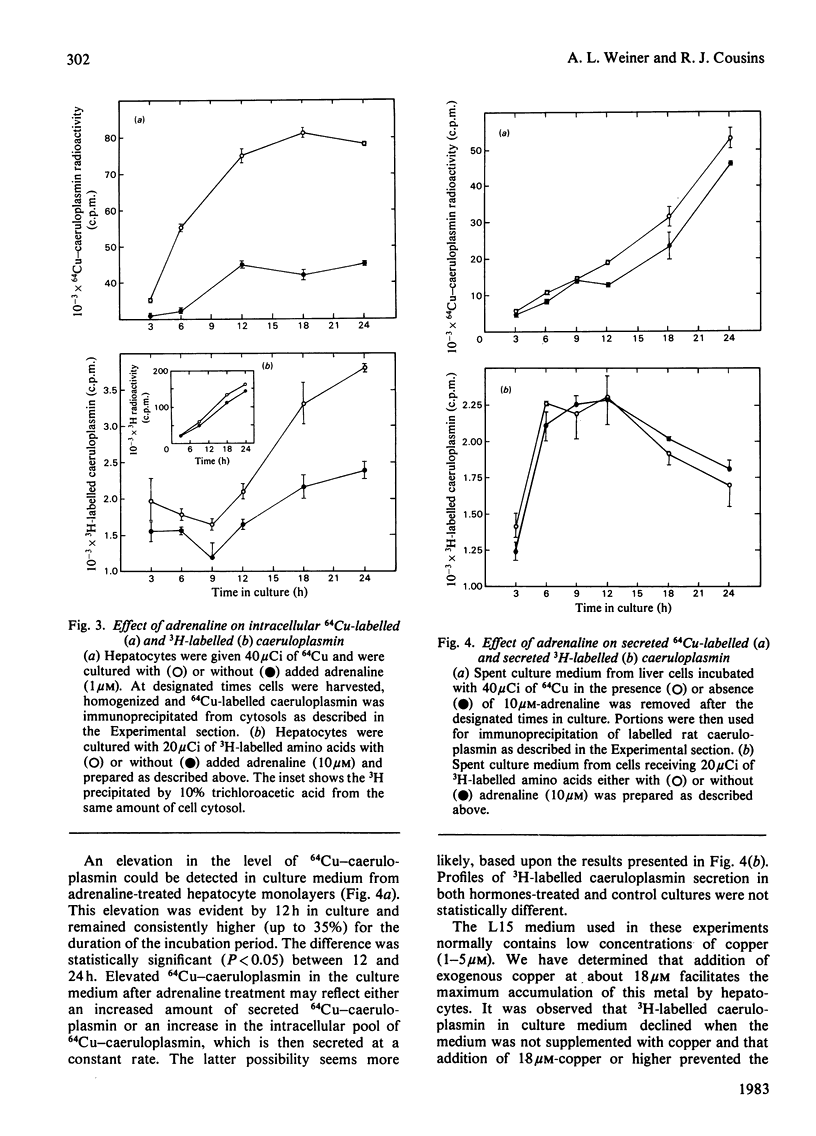
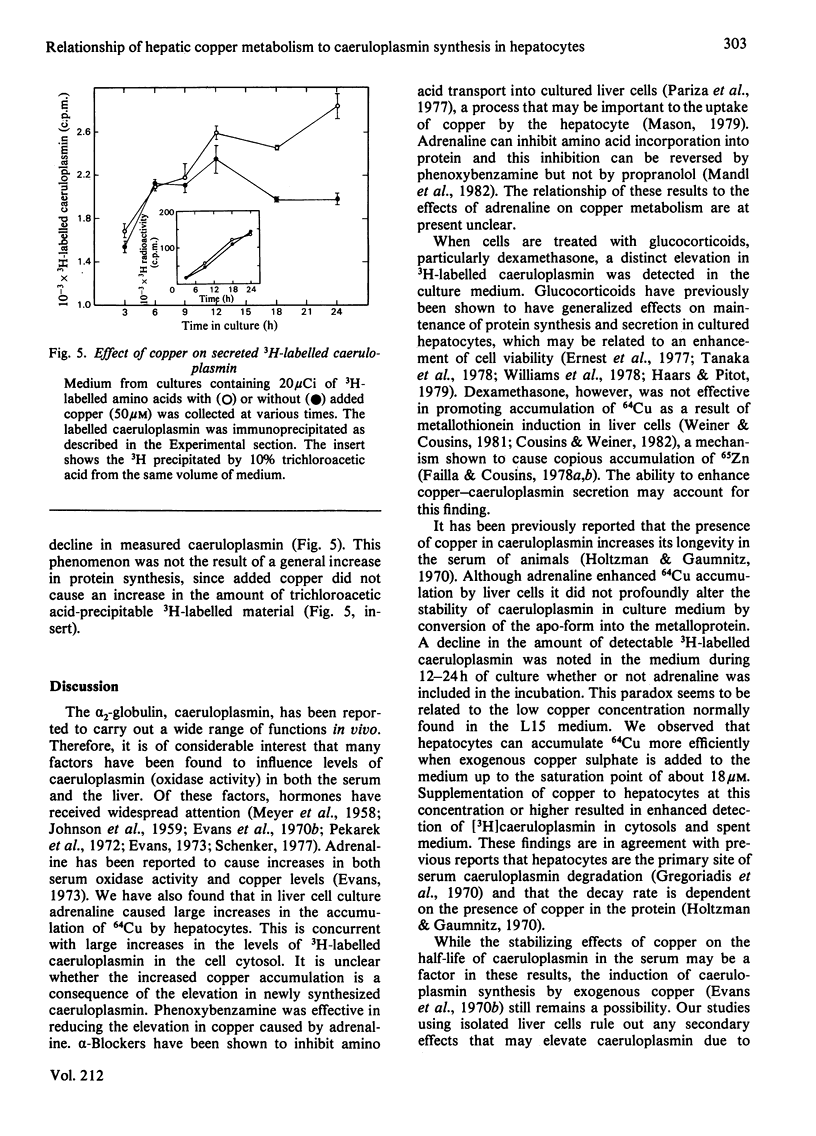
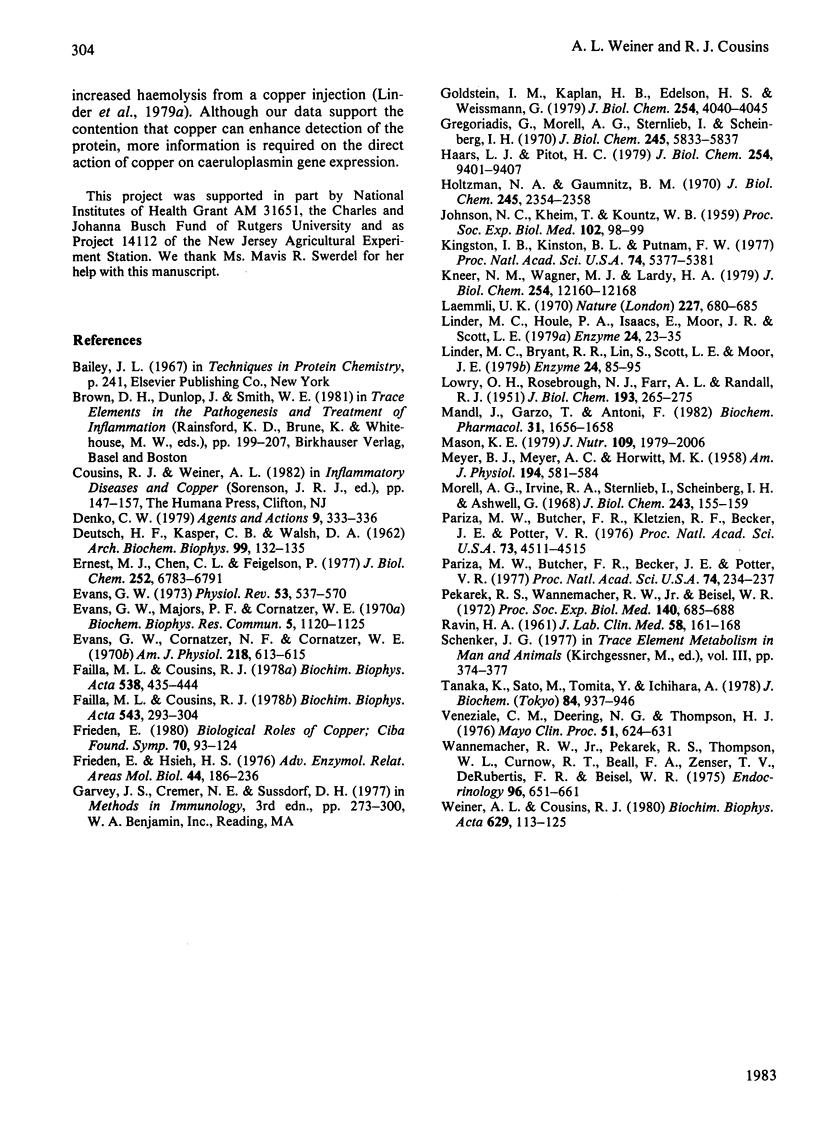
Images in this article
Selected References
These references are in PubMed. This may not be the complete list of references from this article.
- DEUTSCH H. F., KASPER C. B., WALSH D. A. Rapid method for preparation of crystalline human ceruloplasmin from Cohn fraction IV-1. Arch Biochem Biophys. 1962 Oct;99:132–135. doi: 10.1016/0003-9861(62)90255-2. [DOI] [PubMed] [Google Scholar]
- Denko C. W. Protective role of ceruloplasmin in inflammation. Agents Actions. 1979 Oct;9(4):333–336. doi: 10.1007/BF01970657. [DOI] [PubMed] [Google Scholar]
- Ernest M. J., Chen C. L., Feigelson P. Induction of tyrosine aminotransferase synthesis in isolated liver cell suspensions. Absolute dependence of induction on glucocorticoids and glucagon or cyclic AMP. J Biol Chem. 1977 Oct 10;252(19):6783–6791. [PubMed] [Google Scholar]
- Evans G. W., Cornatzer N. F., Cornatzer W. E. Mechanism for hormone-induced alterations in serum ceruloplasmin. Am J Physiol. 1970 Mar;218(3):613–615. doi: 10.1152/ajplegacy.1970.218.3.613. [DOI] [PubMed] [Google Scholar]
- Failla M. L., Cousins R. J. Zinc accumulation and metabolism in primary cultures of adult rat liver cells. Regulation by glucocorticoids. Biochim Biophys Acta. 1978 Oct 18;543(3):293–304. doi: 10.1016/0304-4165(78)90047-8. [DOI] [PubMed] [Google Scholar]
- Failla M. L., Cousins R. J. Zinc uptake by isolated rat liver parenchymal cells. Biochim Biophys Acta. 1978 Feb 1;538(3):435–444. doi: 10.1016/0304-4165(78)90405-1. [DOI] [PubMed] [Google Scholar]
- Frieden E. Caeruloplasmin: a multi-functional metalloprotein of vertebrate plasma. Ciba Found Symp. 1980;79:93–124. doi: 10.1002/9780470720622.ch6. [DOI] [PubMed] [Google Scholar]
- Frieden E., Hsieh H. S. Ceruloplasmin: the copper transport protein with essential oxidase activity. Adv Enzymol Relat Areas Mol Biol. 1976;44:187–236. doi: 10.1002/9780470122891.ch6. [DOI] [PubMed] [Google Scholar]
- Goldstein I. M., Kaplan H. B., Edelson H. S., Weissmann G. Ceruloplasmin. A scavenger of superoxide anion radicals. J Biol Chem. 1979 May 25;254(10):4040–4045. [PubMed] [Google Scholar]
- Gregoriadis G., Morell A. G., Sternlieb I., Scheinberg I. H. Catabolism of desialylated ceruloplasmin in the liver. J Biol Chem. 1970 Nov 10;245(21):5833–5837. [PubMed] [Google Scholar]
- Haars L. J., Pitot H. C. alpha 2 micro-Globulin in the rat. The regulation of the appearance of multiple forms in vivo and in primary cultures of adult hepatocytes. J Biol Chem. 1979 Oct 10;254(19):9401–9407. [PubMed] [Google Scholar]
- Holtzman N. A., Gaumnitz B. M. Studies on the rate of release and turnover of ceruloplasmin and apoceruloplasmin in rat plasma. J Biol Chem. 1970 May 10;245(9):2354–2358. [PubMed] [Google Scholar]
- JOHNSON N. C., KHEIM T., KOUNTZ W. B. Influence of sex hormones on total serum copper. Proc Soc Exp Biol Med. 1959 Oct;102:98–99. doi: 10.3181/00379727-102-25155. [DOI] [PubMed] [Google Scholar]
- Kingston I. B., Kingston B. L., Putnam F. W. Chemical evidence that proteolytic cleavage causes the heterogeneity present in human ceruloplasmin preparations. Proc Natl Acad Sci U S A. 1977 Dec;74(12):5377–5381. doi: 10.1073/pnas.74.12.5377. [DOI] [PMC free article] [PubMed] [Google Scholar]
- Kneer N. M., Wagner M. J., Lardy H. A. Regulation by calcium of hormonal effects on gluconeogenesis. J Biol Chem. 1979 Dec 10;254(23):12160–12168. [PubMed] [Google Scholar]
- LOWRY O. H., ROSEBROUGH N. J., FARR A. L., RANDALL R. J. Protein measurement with the Folin phenol reagent. J Biol Chem. 1951 Nov;193(1):265–275. [PubMed] [Google Scholar]
- Laemmli U. K. Cleavage of structural proteins during the assembly of the head of bacteriophage T4. Nature. 1970 Aug 15;227(5259):680–685. doi: 10.1038/227680a0. [DOI] [PubMed] [Google Scholar]
- Linder M. C., Bryant R. R., Lim S., Scott L. E., Moor J. E. Ceruloplasmin elevation and synthesis in rats with transplantable tumors. Enzyme. 1979;24(2):85–95. doi: 10.1159/000458636. [DOI] [PubMed] [Google Scholar]
- Linder M. C., Houle P. A., Isaacs E., Moor J. R., Scott L. E. Copper regulation of ceruloplasmin in copper-deficient rats. Enzyme. 1979;24(1):23–35. doi: 10.1159/000458625. [DOI] [PubMed] [Google Scholar]
- MEYER B. J., MEYER A. C., HORWITT M. K. Factors influencing serum copper and ceruloplasmin oxidative activity in the rat. Am J Physiol. 1958 Sep;194(3):581–584. doi: 10.1152/ajplegacy.1958.194.3.581. [DOI] [PubMed] [Google Scholar]
- Mandl J., Garzo T., Antoni F. Epinephrine inhibits protein synthesis in isolated mouse hepatocytes through alpha adrenergic receptors in a calcium dependent way. Biochem Pharmacol. 1982 Apr 15;31(8):1656–1658. doi: 10.1016/0006-2952(82)90399-9. [DOI] [PubMed] [Google Scholar]
- Mason K. E. A conspectus of research on copper metabolism and requirements of man. J Nutr. 1979 Nov;109(11):1979–2066. doi: 10.1093/jn/109.11.1979. [DOI] [PubMed] [Google Scholar]
- Morell A. G., Irvine R. A., Sternlieb I., Scheinberg I. H., Ashwell G. Physical and chemical studies on ceruloplasmin. V. Metabolic studies on sialic acid-free ceruloplasmin in vivo. J Biol Chem. 1968 Jan 10;243(1):155–159. [PubMed] [Google Scholar]
- Pariza M. W., Butcher F. R., Becker J. E., Potter V. R. 3':5'-cyclic AMP: independent induction of amino acid transport by epinephrine in primary cultures of adult rat liver cells. Proc Natl Acad Sci U S A. 1977 Jan;74(1):234–237. doi: 10.1073/pnas.74.1.234. [DOI] [PMC free article] [PubMed] [Google Scholar]
- Pariza M. W., Butcher F. R., Kletzien R. F., Becker J. E., Potter V. R. Induction and decay of glucagon-induced amino acid transport in primary cultures of adult rat liver cells: paradoxical effects of cycloheximide and puromycin. Proc Natl Acad Sci U S A. 1976 Dec;73(12):4511–4515. doi: 10.1073/pnas.73.12.4511. [DOI] [PMC free article] [PubMed] [Google Scholar]
- Pekarek R. S., Wannemacher R. W., Jr, Beisel W. R. The effect of leukocytic endogenous mediator (LEM) on the tissue distribution of zinc and iron. Proc Soc Exp Biol Med. 1972 Jun;140(2):685–688. doi: 10.3181/00379727-140-36531. [DOI] [PubMed] [Google Scholar]
- RAVIN H. A. An improved colorimetric enzymatic assay of ceruloplasmin. J Lab Clin Med. 1961 Jul;58:161–168. [PubMed] [Google Scholar]
- Tanaka K., Sato M., Tomita Y., Ichihara A. Biochemical studies on liver functions in primary cultured hepatocytes of adult rats. I. Hormonal effects on cell viability and protein synthesis. J Biochem. 1978 Oct;84(4):937–946. doi: 10.1093/oxfordjournals.jbchem.a132207. [DOI] [PubMed] [Google Scholar]
- Veneziale C. M., Deering N. G., Thompson H. J. Gluconeogenesis in isolated rat hepatic parenchymal cells. IX. Differential effects of glucagon and epinephrine on phosphofructokinase and pyruvate kinase. Mayo Clin Proc. 1976 Oct;51(10):624–631. [PubMed] [Google Scholar]
- Wannemacher R. W., Jr, Pekarek R. S., Thompson W. L., Curnow R. T., Beall F. A., Zenser T. V., DeRubertis F. R., Beisel W. R. A protein from polymorphonuclear leukocytes (LEM) which affects the rate of hepatic amino acid transport and synthesis of acute-phase globulins. Endocrinology. 1975 Mar;96(3):651–661. doi: 10.1210/endo-96-3-651. [DOI] [PubMed] [Google Scholar]
- Weiner A. L., Cousins R. J. Copper accumulation and metabolism in primary monolayer cultures of rat liver parenchymal cells. Biochim Biophys Acta. 1980 Apr 17;629(1):113–125. doi: 10.1016/0304-4165(80)90270-6. [DOI] [PubMed] [Google Scholar]



